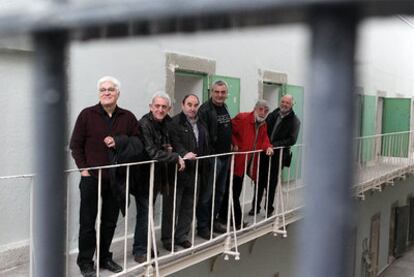Prisoners in the tunnel of time
Six former inmates revisit their old jail from the dictatorship era
"Head count!"
The six men jump at the sound of the shout.
"Christ, my heart just skipped a beat," says one.
It is a joke that startles all of them. The ages of the men range from the late fifties to mid-sixties. At the drop of a hat, they have been taken back 33 years, the length of time they have been at liberty.
"Who are you?"
"We are former prisoners."
"No, we are prisoners, because they never erased our records, nor annulled our sentences."
The six men are in the old Segovia prison, from which two of them escaped in 1976 during an extraordinary breakout that was later made into a film. It is the first time that the former inmates have reconvened behind the bars that a few years ago served as a film set. They are concerned with recovering more recent historical memory, the post-war period in Spain up until the October 1977 Amnesty Law, which gave them their freedom.
"We are prisoners, because they never erased our records, nor annulled our sentences"
They are Sabin Arena, Josu Ibargutxi, Enrique Guesalaga, Xabier Armendariz, Miguel Gómez and José María Galante - Chato. Four Basques, a Zamoran and a Madrileño. They were sent to the Segovia jail because of, in the case of the first four, their association with ETA's VI assembly and, in the case of the others, their association with the Trotskyist Revolutionary Communist League.
"It makes your heart beat faster coming back. It's been many years," says Arana. "It was a commune," adds Galante.
There were around a hundred, mostly political, prisoners held in Segovia. "There was a bit of everything. ETA, the Spanish Communist Party, even the Patriotic and Anti-Fascist Revolutionary Front [FRAP]..."
The visitors are a living book, relating with passion a past that should not be forgotten.
"We staged various hunger strikes, one of them against the executions of 1975. Franco was still alive. And two attempted escapes!"
Ibargutxi and Guesalaga were two of the 29 prisoners - of the V and VI ETA assembly, the FRAP, and the Iberian Liberation Movement - who managed to escape from the Segovia jail in 1976. "We took nine tiles out of the bathroom, replaced them with a board and started to excavate a tunnel to the sewers. Every day we had to stick the tiles back on with toothpaste. There were 54 of us who were going to escape."
A tip-off in August 1975 put an end to the attempt. Another tunnel was started, with the same method. "Twenty-nine of us got out," says Guesalaga. "We crossed Segovia though the sewer system. A truck came to pick us up and we traveled hidden in the back."
The prisoners made it to Roncesvalles, in Navarre, from where they tried to cross the border into France. Only four made it after hiding out for several days. The rest were captured by the Civil Guard. One escapee, Oriol Solé, was killed in a shootout.
"This afternoon, we constitute an association of prisoners of the dictatorship, known as 'The Commune,' to give testimony to what happened. We want all the sentences of the Court of Public Order and the military ones to be overturned," says Galante as he emerges from the room where the tunnel was begun. "We want the right to ask for reparations, although maybe we won't exercise it, and that the Amnesty Law ceases to be a final point for the judgment of the repressive and judicial apparatus of the regime. Crimes against humanity are not covered by it," he adds with emphasis.

Tu suscripción se está usando en otro dispositivo
¿Quieres añadir otro usuario a tu suscripción?
Si continúas leyendo en este dispositivo, no se podrá leer en el otro.
FlechaTu suscripción se está usando en otro dispositivo y solo puedes acceder a EL PAÍS desde un dispositivo a la vez.
Si quieres compartir tu cuenta, cambia tu suscripción a la modalidad Premium, así podrás añadir otro usuario. Cada uno accederá con su propia cuenta de email, lo que os permitirá personalizar vuestra experiencia en EL PAÍS.
¿Tienes una suscripción de empresa? Accede aquí para contratar más cuentas.
En el caso de no saber quién está usando tu cuenta, te recomendamos cambiar tu contraseña aquí.
Si decides continuar compartiendo tu cuenta, este mensaje se mostrará en tu dispositivo y en el de la otra persona que está usando tu cuenta de forma indefinida, afectando a tu experiencia de lectura. Puedes consultar aquí los términos y condiciones de la suscripción digital.
Últimas noticias
The complicated life of Francesca Albanese: A rising figure in Italy but barred from every bank by Trump’s sanctions
How Japan is trying to avert ‘digital defeat’
Half of Scotland is in the hands of 420 property owners
Reinhard Genzel, Nobel laureate in physics: ‘One-minute videos will never give you the truth’
Most viewed
- Pablo Escobar’s hippos: A serious environmental problem, 40 years on
- Why we lost the habit of sleeping in two segments and how that changed our sense of time
- Charles Dubouloz, mountaineering star, retires at 36 with a farewell tour inspired by Walter Bonatti
- Reinhard Genzel, Nobel laureate in physics: ‘One-minute videos will never give you the truth’
- The Florida Keys tourist paradise is besieged by immigration agents: ‘We’ve never seen anything like this’








































